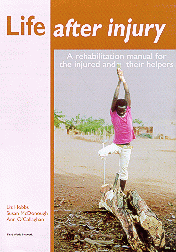|
|
|||
Price (Print version) Free download
(English) Life After Injury is a practical handbook for people who wish to help those injured as a result of accidents, landmines or armed conflict. It is written from extensive experience involving work with village health workers, injured and disabled people, their families and communities. The aim is to build sustainable local capacity for rehabilitation at village level in the poorest communities of the world. The book has far more than physical therapy and rehabilitation. It discusses the full range of understanding and help that severely injured people need to overcome trauma and go on to rebuild their lives with their families and communities. The down-to-earth approach covers a wide range of related problems and needs. These extend from the event of the injury, through emergency care, hospitalization (when possible), learning to do daily activities and finally reintegration into the community. The book also promotes the use of low-cost appropriate technology, splints and aids, training, teamwork and community education. Life After Injury is remarkably broad in scope. It uses numerous illustrations and photos and its clear and simple style of writing can be understood by the community-level rehabilitation worker or village health worker. At the same time, the book provides sufficient detail and depth that fully trained physio and occupational therapists, doctors and nurses will also benefit greatly from it. About the authors The authors - Liz Hobbs, Sue McDonough and Ann O’Callaghan - are Australian physio and occupational therapists. Between them they have visited or worked in rehabilitation programmes in Cambodia, Ethiopia, Sudan, India, Pakistan, Mexico, Thailand, Papua New Guinea and Malaysia, as well as in Australia with both indigenous and non-indigenous people. Their combined experience includes community-based rehabilitation models, cross-cultural training in acute care, medium and long-term rehabilitation, vocational training, low-cost appropriate technology, research and community development. 18.4 x 25.3 cm, 593 pages with over 1,000 illustrations and photos, glossary, index and useful appendices. Paperback only. ISBN 983-9747-77-0 Please contact either of the following to order your copy of Life After Injury: Liz
Hobbs Third
World Network ‘The beauty of Life After Injury is that the authors encourage rehabilitation workers and therapists - in partnership with the injured person and relatives - to sensitively yet systematically evaluate the person’s full range of needs, fears, hopes, and possibilities. Family, and community understanding and support, along with consideration of local and cultural factors, are celebrated as integral to this process. In sum, Life After Injury is a goldmine of comprehensive information for assessing needs and carrying out rehabilitation in difficult circumstances in a way that preserves the dignity and caring human touch of all concerned.’ David
Werner ‘Based on the Ottawa Charter for Health Promotion’s premise that “Health is created and lived by people within the settings of their everyday life; where they learn, work, play and love” and in the tradition of community-based rehabilitation approaches, Life After Injury promotes recovery in the broadest sense - as more than just survival or even access to basic rehabilitation. It encompasses the notions of rebuilding lives and injured and disadvantaged people being able to provide for self and family and fully participate in community life. Ann
A Wilcock ‘Doctors and surgeons often consider the job complete when victims of injury are carried out of the operating theatre - and definitely so when the patients have left the orthopaedic center with a prosthesis on. Twenty years of trauma care and surgery in war zones and minefields in the South has taught us that they are wrong: a lot of trauma victims in poor communities suffer from chronic pain and a sense of worthlessness - so much so that they simply cannot use an artificial limb - much less provide for their family. In fact, poverty is as much a trauma as the injury itself. This book tells how the victim, with his family and with YOU, can find strategies to cope. The book is a MUST for anybody - graduate and non-graduate - involved in trauma care.’ Hans
Husum MD
|
|||
